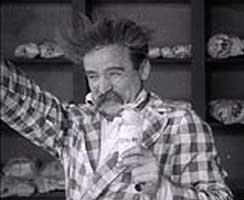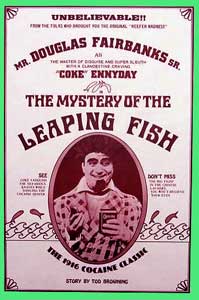With a script by two well remembered individuals --Tod Browning the director of Freaks (1932) with help from D. W. Griffith -- it is not too surprising that The Mystery of the Leaping Fish (1916) has more than a few good moments in it, with lots of bizarre humor.
 Scientific detective Coke Ennedy spoofs the character Craig Kennedy, Scientific Detective, from numerous short stories & novels written by Arthur B. Reeve. It gets a couple wacks in at Sherlock Holmes as well, including Holmes' addiction in cocaine, & a way goofy checkerboard version of Holmes' cloak & deerstalker hat. Scientific detective Coke Ennedy spoofs the character Craig Kennedy, Scientific Detective, from numerous short stories & novels written by Arthur B. Reeve. It gets a couple wacks in at Sherlock Holmes as well, including Holmes' addiction in cocaine, & a way goofy checkerboard version of Holmes' cloak & deerstalker hat.
Reeve's borderline science fiction tales of advanced crime-solving are the actual origins of criminal forensics. When the first police laboratory was established in America, the fiction writer himself designed it! The popularity of his now-forgotten fictional detective was once such that he was easily spoofed in the moving pictures & everyone would instantly get the joke.
Douglas Fairbanks plays Coke as a wild-eyed version of Craig. He keeps a large box of cocaine within reach on his desk, powdering his face with it. His numerous inventions (a few intended for crime-fighting) are in the main rather nutty, though some things, like Coke's television intercom system is pretty darned spiffy for 1916.
 His crazier inventions include a mail slot with robot skeleton that takes the mail, & a clock that tells only four times of the day: time to eat, time to sleep, time to drink, & time to do drugs. His crazier inventions include a mail slot with robot skeleton that takes the mail, & a clock that tells only four times of the day: time to eat, time to sleep, time to drink, & time to do drugs.
The police chief (Tom Wilson) arrives to solicite Coke's assistance in solving a crime. The present mystery begins with an investigation of The Wealthy Gentleman With No Visible Means of Support (Allan Sears), who needs no bedding because he sleeps under heaps of cash.
The Man With No Visible Means hangs out at a seaside rental shop. The most popular of the rental items is a "leaping fish" floatation device costing twenty-five cents per hour. These have become a local fad, pointy hollow tubes with two flippers, but ah-ha, they might also be used by smugglers.
Coke arrives in his checkerboard detailed auto with his box of disguises most of which include hats or jackets with the same checkerboard design. While looking into the Man's swimming rentals, Coke nearly drowns himself except he's saved by the heroine of the tale, Inane (Bessie Love) whose name spoofs the Craige Kennedy heroine Elaine, who had her own silent film detective adventures, i.e., The Exploits of Elaine (1914) starring Pearl White as Elaine & Arnold Daly as Craig Kennedy.
Coke is on the trail of the smuggling racket while trying to save luckless Inane from kidnapping & an unwanted marriage. The smuggler is in cahoots with the Sum Hop Chinese laundry. They are bringing drugs into the country. When Coke discovers it's a shipment of Opium, he's just so darned happy, & immediately gets wasted.
The funky autos are quite amusing, & scenes alleging to be Chinatown give the story a slight Yellow Peril theme of interest in the history of racism in the cinema. The Chinese laundryman has kidnapped Inane & thinks he has mesmeric powers, as Chinese villains often do in old movies. But when he gives her a hypnotic order to do as he commands, she beats the living hell out of him.
Meanwhile Coke Ennedy arrives, his mustache disguise hanging loose on one side as usual. There's an actioin-packed comic fight made really strange by everyone's drug use.
We're also treated to a brief Keystone Kops parody as the lost police speed round & round a traffic island. But since the Keystones, who debuted in 1913, were already pretty funny, this spoof adds nothing special in that direction, & is more a brief homage.
The Mystery of the Leaping Fish is an enjoyable relic. It has such peculiar art design & such an oddly uncritical attitude toward drug use that it is at the very least endlessly curious. To anyone who has ever read some of the Craig Kennedy short stories (largely unremembered today), this spoof will have an extra layer of delight.
copyright © by Paghat the Ratgirl
|

 Scientific detective Coke Ennedy spoofs the character Craig Kennedy, Scientific Detective, from numerous short stories & novels written by Arthur B. Reeve. It gets a couple wacks in at Sherlock Holmes as well, including Holmes' addiction in cocaine, & a way goofy checkerboard version of Holmes' cloak & deerstalker hat.
Scientific detective Coke Ennedy spoofs the character Craig Kennedy, Scientific Detective, from numerous short stories & novels written by Arthur B. Reeve. It gets a couple wacks in at Sherlock Holmes as well, including Holmes' addiction in cocaine, & a way goofy checkerboard version of Holmes' cloak & deerstalker hat. His crazier inventions include a mail slot with robot skeleton that takes the mail, & a clock that tells only four times of the day: time to eat, time to sleep, time to drink, & time to do drugs.
His crazier inventions include a mail slot with robot skeleton that takes the mail, & a clock that tells only four times of the day: time to eat, time to sleep, time to drink, & time to do drugs.